Men Who Talk With Trees Part II
Life and Island Times – June 5 2016
Men Who Talk With Trees Part II
This morning your scribe sat down to read what he had found the previous evening. In a 2002 story Jeff Klinkenberg of the St Petersburg Times connected the dots of two tree addicts in the Keys that Marlow knew (Nick Downs and Kenny King) to a heretofore unknown third. After reading it, it was clear that they were not wood hoarders, aficionados or fetishists but rather craftsmen, ecologists and real Floridians.
So without further ado, here is Jeff’s April 7 2002 article:
PLANTATION KEY — Another hurricane season is around the bend, thank heavens. Jack Kepler can hardly wait for the big winds.
Starting in June he’ll tune his television to the Weather Channel and his radio to hourly tropical forecasts. Driving down U.S. 1 through the Upper Florida Keys, he’ll flash “thumbs up” to friends who profess to understand his peculiar obsession.
Jack Kepler is known as the chairman of the board. He loves wood, everything about it, from its weight to its texture and even its smell. He says wood talks to him, whispers, shouts and even begs.
He builds things out of the rare tropical hardwoods that grow in the Keys. But since it is unlawful to harvest living trees here, he has to wait until they’re dead.
They are often killed by tropical weather. In 1992, hours after Hurricane Andrew roared through South Florida, he placed a classified ad in the Miami newspaper. In one morning he answered 37 calls alone from Ocean Reef, a ritzy community in Upper Key Largo. Homeowners begged him, please, take the mahogany that crushed my Mercedes.
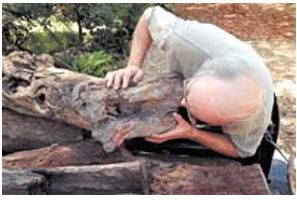
Kepler inspects mahogany logs that were recovered from Hurricane
Andrew in 1992. Kepler and a few woodworker friends recovered
more than 50 tons of tropical hardwoods after the hurricane.
Kepler loaded his chain saws and mounted his sawmill on a boat trailer. For weeks he cut trees and turned them into boards. When he was finished, he had piked about 50 tons of lumber stored under his stilt house on Plantation Key.
He has about 30,000 feet of lumber stored at his house right this minute, more than enough to build a pretty good home or thousands of the exotic wood sculptures and furniture for which he is famous. But to his eye, 30,000 feet of lumber looks a tad skimpy.
A wood addict always wants more.
“Last hurricane season was very disappointing,” he says. “On the first day, I mean June 1, there was something tropical out there that looked like it might develop into a hurricane and hit the Keys. But then it spun out into the Atlantic. We didn’t have anything worth talking about the rest of the year.”
His mouth puckers as if he’s bitten into a key lime.
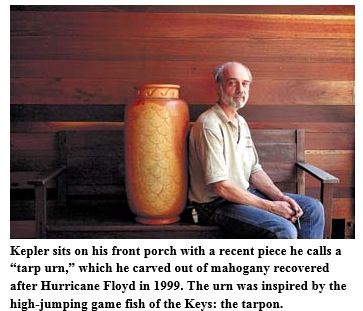
The Kepler cathedral
Kepler, 50, “is weirdly, wonderfully Keysian,” says novelist James W. Hall, who lives part of the year in Key Largo and sets many of his mysteries in the Keys. In other words, Kepler looks at life with an eccentric’s eye. He’s an unreconstructed hippie who has a salt-and-pepper beard, is seldom seen without a Miami Dolphins cap covering his bald pate, doesn’t eat red meat, smokes Raleighs by the score, makes a lot of money, turns down business if he takes a dislike to a customer and knows the Latin names of hundreds of tree species but likes the word “ain’t.”
A few years ago, Hall made a pilgrimage to Kepler’s home to research how somebody might build a house from salvaged tropical hardwoods. Kepler was such a perfect fit he became a character in Hall’s next novel, Tropical Freeze.
“Jack’s a very cool guy,” Hall says. He calls Kepler’s house “Mr. Natural’s cathedral.”
The Kepler cathedral features winding staircases, magnificent decks and doors that weigh hundreds of pounds. Patterns on his wood swirl and dance. What other builders see as ugly — a knot or a bump — he sees as beautiful. He’ll carve a loggerhead turtle out of imperfection.
He started building the house in 1979. It’s not quite finished, but it probably never will be. As a new storm comes along, ideas pop into his head.
“I was known as ‘Have Chain Saw, Will Travel.’ I’d go anywhere, any time.”
When he read about old homes in West Palm Beach scheduled to meet a bulldozer, he sped up the turnpike in time to salvage lumber. Dade County pine, so hard it thwarts termites and even nails, was used up by the middle of the 20th century. But now the remnants he has salvaged make a floor in his dream house.
He read about a problem at the Port of Miami, where ships from Asia arrived bearing new yachts encased in giant wooden yokes made from tropical rain forest trees. The port was paying $50 to anyone who’d haul away a yoke. Kepler was a frequent visitor. He needed exterior walls.
He depended mostly on the Florida hardwoods, the gumbo limbo, wild tamarind, ironwood and mahogany, for construction. And they seemed to be calling him.
A terrible fire, sparked by the old Flagler Railroad, swept Key Largo in 1915. Blackened dead trees stood in lonely desperation for decades.
Until Kepler volunteered to take them.
Behind the burnt bark was perfectly aged wood. His bathroom walls, provided by the fire, are Jamaica dogwood. If you could buy such wood, and don’t bother going to Home Depot for a truckload, it would cost five grand for your bathroom.
The fire was kind to Kepler. He also got a nice collection of lignum vitae, perhaps the most valuable tree in the Keys. He used it in his shutters and in his drawers. Speaking of drawers, you ought to see the ones he built in the kitchen for his wife, Phyllis. They don’t look like drawers at all. They look like wall. But stick your finger in a knot and voila! Out roll drawers. They came from a spalted Indian tamarind that fell in a neighbor’s yard during a thunderstorm. (Spalting is a by-product of the rotting process that can cause unusual patterns and colorations in wood.)
He doesn’t like nails. His boards are held together by homemade wooden pegs made from the ironwood tree he recovered in that burned-out forest.
His house probably is worth millions, but he is not sure. After all, he got his wood mostly for free and did the work himself. But if he had to pay for it? Mahogany, if you can find it, often goes for about $35 a foot. Multiply that by about 30,000 feet. And then add in a few thousand board feet of rare woods.
But Kepler has no insurance.
“Don’t believe in it,” he sniffs. “I built the insurance into this house. It’s built with the hardest woods on earth. If a storm is tough enough to knock down my house, well, my house ain’t going nowhere. I’ll just have to find it and bring it back in one whole piece.
“I tell my wife: ‘Just keep me healthy. I can build anything, fix anything.”‘
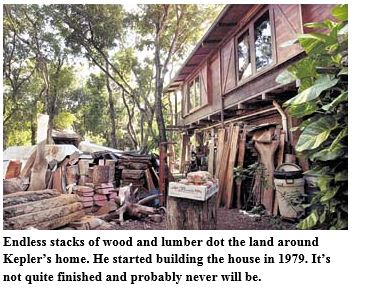
Sawdust in his blood
Working with wood is part of the Kepler genetic code. He was born in Illinois but grew up in Wisconsin, where his father was a prominent builder and his mother was known for her woodworking. At 13 he was making $7 an hour as a carpenter; at 16 he designed a house his father built; as a high school senior, he taught drafting to freshmen. He built his first house when he was 18.
“I didn’t go to college,” he says. “What did I need that piece of paper for? I knew what I wanted to do.”
So he moved to the Upper Keys, where his parents had owned a winter home, and worked as a carpenter and bartender. Getting started on his dream wasn’t easy.
First, he had to move temporarily back to Wisconsin in order to marry Phyllis, whom he had met at a birthday party when they were teenagers. He brought her back to the Keys, where they lived in a trailer in a wild, buggy, tropical hammock.
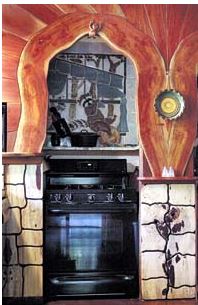
Kepler’s kitchen alcove is made of native mahogany,
top, that was recovered after Hurricane Andrew.
Below are the tamarind pantries carved to resemble stone.
Jack worked as a handyman, Phyllis as a nurse and cheerleader who didn’t mind sawdust in bed. “I knew what to expect when I married him,” she says.
Wood calls his name. It calls to him from the beach next to the Channel Five Bridge. He finds it in piles at construction sites in Marathon. The Coast Guard called about an 84-foot gum tree it had towed from a shipping channel and left on the beach.
Later, he traded some of the lumber for an air conditioner and began building the air-conditioning ducts. In almost every house on earth, air-conditioning ducts are metal. His are made from the Coast Guard’s gift tree, which Kepler thinks toppled into the Mississippi somewhere north of Missouri, flowed with the current into the gulf, then somehow drifted over months or years toward Florida, to the Keys, to his sawmill.
He has built no other houses. But he is often paid handsomely to build something for other homes, sometimes cabinets or window frames or furniture or giant vases onto which he has carved tarpon scales.
Recently he constructed a stair railing for a millionaire. At the top of the stairs, he carved a couple of parrots into the railings. At the middle of the stairs he carved mangroves. At the bottom of the stairs — in his mind a coral reef — he carved a moray eel.
His bill?
Fifteen grand.
Risks and recycling
Kepler is one of those people who hates sleep. He rises at 3 a.m. and walks to the Marlin convenience store for coffee and a quiet read of the Miami Herald. At sunrise, he hits 100 golf balls to focus his mind.
Then he gets to work. He might be building an altar for a local church or a door for a friend who gives him yellowtail snapper filets in return. Sometimes he prefers barter to pay. He built kitchen furniture for a chiropractor who treated his bad back for a year.
The woods he uses are extremely heavy. Take ironwood. An ironwood board, 24 inches long, 8 inches wide and 1 inch thick, weighs approximately 20 pounds. “Don’t grab if you’re in a boat that’s sinking,” he jokes.
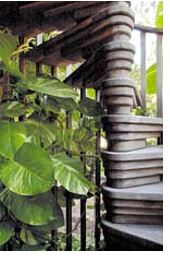
The winding stairway leading to the front porch of Kepler’s
house is made from mahogany native to the Keys.
“Mahogany owns my heart,” Kepler says.
He traded his beloved sandals for steel-toed shoes after he accidentally kicked a wild tamarind and ended up with an 8-inch splinter piercing the arch of his foot. “You have to be very careful when you work around saws and heavy wood,” he says. “When I make a mistake, I quit for the day and write myself a note: ‘Jack, that was very, very stupid.’ ”
He wears a ventilator mask while sawing mahogany. Its dust makes his throat swell shut. He no longer messes with poisonwood after the sawdust prompted another trip to the emergency room.
Mosquitoes whine about his head. He never slaps them. Nor does he harm the giant scorpions inhabiting his woodpile. He believes in karma. The only time he squashed a scorpion, he was stung hours later by an even larger one.
Some critters in his neck of the woods are more dangerous than scorpions. Fortunately, they make noise. Unfortunately, he is somewhat hard of hearing after years of listening to chain-saw symphonies.
“Hey, Jack, move, will you?” hissed a neighbor not long ago. Kepler retreated a few steps. He had failed to notice the rattle of the big Eastern diamondback that slithered out of his woodpile.
“I don’t kill rattlesnakes, either,” Kepler says defiantly. “Why should I? They eat rats, and they have the same right to live as I do.”
He considers himself an environmentalist. He says he is against logging in tropical forests. He grins whenever he hears that a wood thief has been apprehended at Dagny Johnson Key Largo Hammock Botanical State Park or Crocodile Lake National Wildlife Refuge or John Pennekamp Coral Reef State Park. The preserves contain the last of North America’s tropical hardwood forests and have become a magnet to wood rustlers.
“We think of Jack Kepler as a good guy,” says Jim Duquesnel, the biologist for the Keys state parks.
In fact, the parks have Kepler’s name on a list, just in case they need somebody to remove a foreign tree that doesn’t belong in a Florida Keys hammock.
A scientist’s trash is a wood addict’s treasure.
“He absolutely hates waste. Loathes it. Can’t tolerate it,” says Hank Gilpin, a prominent New England sculptor who buys lumber from Kepler. “He loves trash. It’s wood other people typically haul to the landfill or to the woodchipper.
“To Jack, it’s treasure. He looks at a pile of discarded wood and sees dolphins leaping out of it.”
Calling Nick to confirm the above, Marlow was not surprised to learn that all three knew each other. Nick and Kenny oftentimes called Jack to sell him logs of trees that they knew Jack wanted for projects. Whatever Jack bought saved Kenny and Nick the $180 per ton tippage fee at the local dump and made them a lot of money from time to time.
Copyright © 2016 From My Isle Seat/St Petersburg Times
